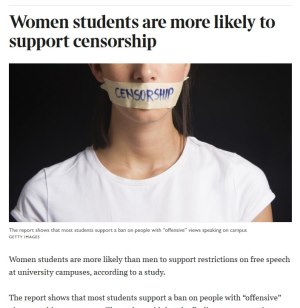Why has America changed so dramatically over the past fifty years?
Originally published June 16, 2014.

“Suppose truth is a woman—what then?” asked Nietzsche with a chuckle.
His aim, in that opening line of Beyond Good and Evil, was to tell us something about truth. But in so doing he touched on some old assumptions about women: their inconstancy, their irrationality. The dogmas of the day, Nietzsche meant, were neither as immutable nor as reasoned as people assumed.
That skepticism was a lit fuse that led to the destruction of many traditions, including, ironically, men’s traditional underestimation of the fairer sex. Women soon got the vote in Western countries. In one world war and then another, they entered the workforce en masse, and increasingly stayed there during peacetime. Slowly but surely they took positions of influence, becoming doctors and lawyers, editors and producers, novelists and journalists, CEOs and politicians—even presidential candidates.

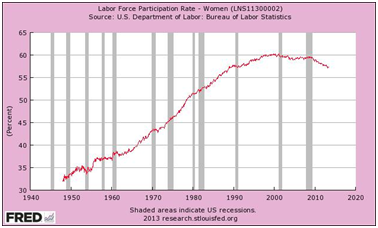
By 1985, a century after Beyond Good and Evil was published, more women than men were graduating from college in the United States—and that gender gap would keep getting bigger.
This relatively quick and historically unprecedented surge of women into public life—and, in recent decades, into positions of strong cultural influence—must have had significant cultural consequences. Culture regulates the way that people think and act, especially in public life, and women tend to think and act differently than men, so it follows that their new influence should have shifted Western culture, feminizing it to some degree. Why has so little, if anything, been written and said about this shift?
One could hardly argue that there is no shift to explain. Here are just some of the major social changes that have occurred in the past fifty years in the US—changes that seem quite sudden in historical terms:
Widespread dependence on government: More than 100 million Americans now receive means-tested federal welfare benefits, which don’t include Social Security or veterans benefits. About 47 million Americans receive food stamps. Close to six percent of the U.S. working age population now receives payments from the Social Security disability fund, compared to less than one percent in 1960. In most states, welfare recipients can receive income well above the minimum wage equivalent. All in all, entitlement spending (including related debt-servicing payments) now absorbs about 70% of the federal budget, up from about 30% in 1960. However, the poverty rate is about the same as it was in 1965. Meanwhile the labor participation rate for men (see blue chart above) has been falling more or less steadily and is at all time lows.
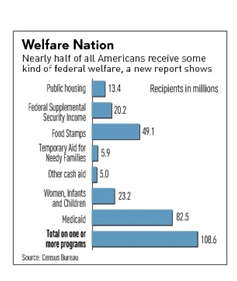
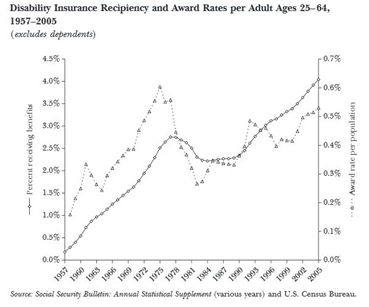
Civil rights expansions and set-asides: including minority-preference affirmative action hiring and contracting policies, “hate crime” laws, the Supreme Court finding that the Constitution effectively bars state laws against gay marriage (and child rearing), the admission of women into combat units in the military, plus the extralegal social ostracism of any public figure uttering politically incorrect speech.
Abandonment of traditional restrictions on immigration: In the early 1960s most immigrants to the US came from Europe or Canada and thus reflected the ethnicities of the existing American population. Since 1965, immigration laws and policies have become much more liberal, resulting in a radical change in the ethnic/cultural influx. Now the top five sources of immigrants are Mexico (dwarfing all others), China, India, the Philippines and Vietnam. The foreign born population in the US, as a percentage of the total population, is almost three times what it was in 1960. From 1960 to now Hispanics have increased their percentage of the population from 3.6% to 16.4%. The number of illegal, undocumented immigrants in America is also now huge, apparently between 10 and 20 million—equivalent to a medium-sized city’s worth of illegals per state. Not only the dynamic economy but also the growth of welfare programs in the US have created huge incentives for immigrants both legal and illegal. Some states even allow illegal immigrants to have driver’s licenses and taxpayer-subsidized benefits.
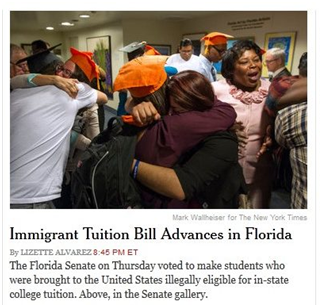
A decline in the acceptability of military deaths and judicial executions: In all the years of US military activity in Kuwait, Iraq and Afghanistan—which is to say, almost continuously from 1991 to the present—there have been only about 5,400 US combat deaths. And that has been scarcely tolerable, even though about 50,000 Americans died in Vietnam, 300,000 in World War II, and 600,000+ in the Civil War. Meanwhile capital punishment is clearly on the way out.
A nation of victims: Declaring oneself a victim of something terrible—even something self-inflicted—has become a major theme in American culture: in media stories, in modern psychiatry (PTSD and other trauma-related ailments), and even in contemporary literature where it has dominated for years. Meanwhile on campus, some consider any text a potential source of trauma and victimization, requiring “trigger warnings” to protect the sensitive.
A shift in foreign policy: The US has always been evangelical about its ideals, sometimes to the detriment of relations with countries that would otherwise be allies. That is true more than ever today, but the “American ideals” being pushed on countries like Saudi Arabia and Afghanistan and Kenya now include women’s rights and even LGBT rights. Since 1997, the State Department has usually been headed by a woman (Albright, Rice, Clinton).
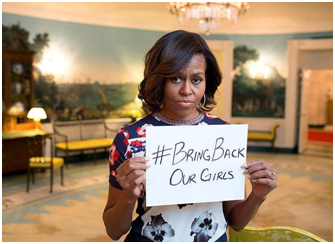
Back to nature: From Rachel Carson to Global Warming and the anti-GMO movement, Americans have become energized about environmental issues as never before. The increase in environmental consciousness has been accompanied by an increasing preference for more “natural” foods and medicines. At the same, more and more Americans have been joining New Ageish, nature-oriented religions, such as Wicca, which is often described as the fastest-growing religion in the country. This rise in freewheeling nature-oriented religions has been accompanied by declines in traditional, hierarchical Christian denominations such as Roman Catholicism, Episcopalianism and Lutheranism.
New modes of public argument: Debate over public policy these days seems to have less and less to do with sober calculations of long term consequences, and more and more to do with dramatic anecdotes that make immediate appeal to our empathy: the poor immigrant yearning for a new start in the land of freedom; the inmate facing inhumane execution, who just might be innocent; the gay couple who want only to be treated the same as their straight-couple friends; the rape victims of Rwanda or the Congo, or the US Naval Academy. There is also now a heavy emphasis on protests and marches, heckling, breast-baring, blood- and egg-throwing, ad hominem attacks, silencings of would-be speakers, and other non-rational or even anti-rational tactics.
Empathy and compassion
Many of these changes are consistent with a cultural shift in favor of empathetic compassion. America over the past few decades has somehow acquired more and more sensitivity to the needs and claims of traditionally disadvantaged minority groups, would-be immigrants and illegals, those who claim to have experienced trauma or injury—basically anyone with a sob story.
This is the precisely the change that we should most expect as women gain greater influence over policy and the wider culture. A greater tendency towards empathy and compassion are among the most distinctive features of the female mindset. Even Aristotle, 2,400 years ago, noted that woman was “more compassionate” and “more easily moved to tears.”
This type of sensitivity presumably is a deep trait that evolved because it is adaptive for child-rearing. Certainly it is common for women to display that trait when raising a child, for example in shielding the child from challenges or risks to which a more coldly rational father is willing to expose him. The Cambridge University psychologist Simon Baron-Cohen, who researches gender differences, has long argued that “[t]he female brain is predominantly hard-wired for empathy. The male brain is predominantly hard-wired for understanding and building systems.”
Note that the empathy that moves one to compassion tends to have a certain emotional narrowness and immediacy: “I feel your pain.” It’s not a deliberate, logical weighing of long-term consequences, and it typically is meant to ameliorate the plight of an individual or narrowly defined group, with little thought for wider implications.
America’s immigration policy, to take one example, was once largely based on considerations of long-term consequences, including the adverse social consequences of bringing in millions of people from Third World societies. That policy, now deemed racist, has been replaced by a policy that is to a great extent about satisfying the immediate needs and aspirations of individual immigrants. Ditto for welfare, where the policy tends to focus more on the immediate claims of claimants and less on the adverse society-wide consequences (reducing motivation to work, eroding families, busting budgets). Ditto again for admitting women to combat roles in the military—which is about fulfilling the aspirations of a small number of individuals rather than optimizing the services’ overall warfighting capability.
I would be surprised if the new influence of women on American culture were the only factor in this shift towards more empathy-based attitudes and policies. Television, for example, which spread widely into US homes beginning in the 1960s, has tended to bias debates in favor of the side that can muster more compelling visual images—and videos of people expressing strong emotions tend to be more compelling than, say, bar charts depicting long term consequences. But I wonder if TV’s influence could have been as great, had policymakers and persuaders not become so receptive to that influence—because they were increasingly female.
Environmentalism and witchery
Pregnancy brings out some remarkable instinctive behaviors that give us further hints about the “hardwired” traits of women. I am referring to the smell and taste aversions that appear mainly in the first trimester, and the “nesting instinct” that occurs in the second or third. None of these behaviors is deliberate and rational—that is what can make them so disturbing to the pregnant woman and her loved ones—but they appear to have evolved to help keep the baby safe from toxins, germs and other harmful environmental influences.
I suggest—that is all I can do at this point; there is little published research in this area—that these deeply rooted traits, which appear to be influenced by levels of estrogen and related hormones, would also manifest to some extent outside pregnancy. They would show up, for example, in a tendency to be more concerned (than men are) about putative environmental threats.
Again, there is no definitive research on this question. But there is some evidence that women (compared to men) tend to put more emphasis on pro-environmental issues, are less likely to be global warming skeptics, and are more likely to choose eco-packaging. Women also are heavily represented in pro-environment groups such as Greenpeace and the anti-GMO movement.
Related to this “green” tendency may be women’s seemingly greater aversion (on average, compared to men) towards modern, industrially produced foods and medicines, and the recent, swift rise in popularity of “natural” alternatives—purchased mostly by women.
The trend towards natural remedies appears to be related to New Age and witchcraft religions with their pre-scientific, eye-of-newt style systems of “healing.” These alternative religions obviously strike other chords in some women, and while I’m no expert on the matter, presumably one attraction is that the new religions give women more interesting and flexible roles than they would have had in traditional, patriarchal Christianity (e.g., lusty witch vs. celibate nun).
The same suspicions of modern, technologically produced food and medicine appear to have encouraged the ongoing anti-vaccine movement, and the spurious “detox” intestinal cleansing fad, both of which have been largely female social phenomena, heavily promoted by female celebrities such as Jenny McCarthy and Gwyneth Paltrow.
Unreason, contagion, victimization
In the list of big social changes above, I mentioned an apparent trend towards the use of non-rational or even anti-rational tactics in public arguments: for example, the demonization and silencing of opponents as alternatives to reasoned debate, and the rejection of due process in many cases where women are the accusers and men the accused. Is this too part of our cultural feminization? Historically men have believed that women are less rational, less reason-guided, in contexts where they are trying to persuade. Obviously this notion is offensive to modern women and to a great extent it does stem from the casual misogyny of the past. Then again, every modern study I’ve seen that touches on this particular question—check out this one from 2003—suggests that women are indeed markedly less supportive of free speech rights, and more emotionally sensitive to speech with which they disagree.
From an anthropological perspective, it makes perfect sense that women and men in the course of human evolution would have acquired (again: on average—think of two overlapping Bell curves) cognitive and other psychological differences, stemming from differences in their traditional roles, e.g., women as nurturers vs. men as hunters, warriors and leaders. In particular, women’s apparently greater weighting of emotion and empathy implies a correspondingly reduced weighting of more abstract and emotionally neutral mental operations. It’s easy to imagine that throughout human history women in effect have been engaged in a “mental arms-race” with men, evolving their own distinctively female set of cognitive and persuasive weaponry. That we still tend to hold up the chief “male” weapon, reason, as the highest mental faculty, may be due in large part merely to men’s historical hegemony in intellectual matters—so that, as that hegemony slips, the special status of reason can be expected to slip too.
The late 20th and early 21st centuries also have been marked by tremendous social contagions, from epidemics of arguably fake diseases (e.g., multiple personality disorder) to routine media-driven outbreaks of “outrage,” particularly of the politically correct variety—commonly compared to the witch-hunts of old. Is the cultural ascendancy of women to blame for this trend too?
Perhaps it is. If empathy is the ability to feel what others are feeling, then a more empathetic person is mentally more connected—more acutely and immediately connected—to others and in general to her social surroundings. Though much of it is anecdotal (not nearly enough experimental work has been done in this area) there is some evidence that women do tend to have greater “connectedness” in this sense. For example: Women and girls, versus men and boys, are more likely (about twice as likely) to be diagnosed with PTSD after trauma. They tend to be more interested in social networking. They are more hypnotizable and suggestible (and become moreso when pregnant). They are more likely to confabulate false memories and participate in mass psychosomatic incidents of the kind that, for example, spuriously sicken anxious schoolchildren every year.
Women moreover have been the initiators and principal transmitters of the most notorious hysterical contagions in history. These include the original witch-hunts—the convent demon-possessions of early 17th century France, for example, and the later, much more lethal bewitchment-accusation craze in Puritan New England—as well as the hysterical neurosis syndromes that so captivated Charcot and Freud, and the related recovered-memory epidemics of recent decades. (Although historically in the West these have seemed to be isolated outbreaks, there is a substantial anthropological literature suggesting that women in premodern, patriarchal societies routinely—and competitively and contagiously—use “spirit possession” and similar tactics for mundane ends.)
Note that these female-driven contagions, across wide stretches of history and culture and including our modern outbreaks, have all in some way been about claiming the status of victim, for oneself or for someone else. I don’t know that “playing the victim” is a latent reflex in the female psyche, but it would make sense in terms of evolutionary psychology if the physically weaker sex, over tens of millenia of social evolution, had developed a reliance on such passive strategies. If it did, then women’s new cultural ascendancy would virtually guarantee that victimization stories become as prominent in media and influential on policymaking as they are.
Does all this strike you as unacceptably inflammatory and insulting speculation? If so, you’re in good company. Already many areas of scientific research (e.g., cognitive differences between men and women, or among ethnic groups) are effectively off limits, and the idea of overtly banning certain types of inquiry is now almost mainstream. Interestingly, this trend has been pioneered by some of the institutions that should best symbolize the free-inquiry ideal.
Consider what happened at Harvard in 2005—a classic case of clashing mindsets. The Harvard President at the time, Lawrence Summers (later of the Obama Administration), was under pressure to increase female enrollment in technical degree programs. One day Summers gave a talk that touched on this delicate subject. He suggested, based on published data, that men as compared to women don’t necessarily have more aptitude on average for technical subjects—but they do have a wider distribution of aptitude, i.e., longer tails on their Bell curves, so that they are marginally more likely to be geniuses or dullards. The slight surfeit of male high-achievers, he went on, might help explain why men still dominate the very limited number of “tenured positions in science and engineering at top universities and research institutions.”
As tame and defensible as such a suggestion might seem, Summers’s willingness to contemplate any sort of gender-based difference in aptitude was enough to trigger outrage, and a long and painful inquisition. The psychologist Steven Pinker and a few others strongly backed Summers, and Summers himself made several abject public apologies (“…I was wrong to have spoken in a way that has resulted in an unintended signal of discouragement to talented girls and women…”) but the Harvard faculty soon passed a motion of “lack of confidence” in his leadership. Summers resigned the following year.
In this episode the loudest cries of condemnation came from female academics, and the weird part of all this is how unselfconsciously some of them displayed a clichéd femininity—as if, in our brave, new, pink-tinted world, they had no further need to conceal their cognitive differentness, notwithstanding the issue at hand! Amid the uproar, for example, one woman professor dramatically told a New York Times reporter: “When he started talking about innate differences in aptitude between men and women, I just couldn’t breathe because this kind of bias makes me physically ill.” [italics mine]
Here’s to the new boss
What I’ve written above will seem biased against women. But I could have constructed an argument about the negative features of Western societies before the recent ascendancy of women: much more violence and acceptance of violence, for example, and more susceptibility to complex, inhumane ideologies—given the dominance of a testosterone-driven, lower-empathy, compulsively system-building (i.e., male) brain.
Anyway this essay isn’t really about the rightness or wrongness of the social changes that have occurred in America. It is about the likely origins of those changes. Admittedly, though, if those changes arose mostly from a simple demographic shift, then that would tend to undermine the claim that they represent an inevitable Progress. Moreover, one might wonder whether, in the long run, a mindset that evolved not for the “understanding and building of systems” (Baron-Cohen’s words) but for tasks such as child-rearing can succeed in the management of complex modern societies and states. Conceivably it will succeed; conceivably it will turn out to be better suited (than the traditional male mindset) for a modern, relatively peaceful world. But just as conceivably, or maybe a lot more conceivably, empathy-driven feelgood policies in the long run will lead, even in countries that had been rich and stable, to fiscal and social collapses—creating opportunities that less feminized cultures will want to exploit.



Even if such a cataclysm never comes, the fact is that something fundamental has changed in the inner workings of the modern world. The structures of societies are already adjusting and realigning in response. But, curiously, the nature of the change is such that no one seems to want to talk about it or even acknowledge it.
